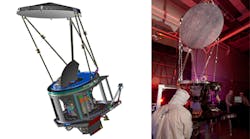Precipitation Microwave Imager Flexes Its Frequency Range
NASA’s Global Precipitation Measurement (GPM) mission is a collaborative, international effort that aims to improve weather and climate predictions by accurately measuring precipitation (see “Microwave Technology Extends Satellite Precipitation Coverage” on Microwaves & RF). The first satellite of the mission, the Core Observatory, carries an advanced global microwave imager (GMI). That imager uses highly sensitive frequencies to discriminate between the noise and signatures of small particles of precipitation.
The GMI, designed by Ball Aerospace, is a conical-scan microwave radiometer with 13 channels that operate from 10.65 to 183.3 GHz. It has a 1.2-m aperture that results in resolution of 4.4 to 32 km. At approximately 8 ft. tall, it rotates at about 32 revolutions per minute. To greatly reduce its mass, the GMI was fabricated with graphite composite structures as opposed to aluminum. In addition, a specialized circuit design supposedly reduces power consumption by 20% compared to previous radiometers.
Observations of rain and snow are provided every three hours in conjunction with a dual-frequency-precipitation-radar (DPR) instrument built by the Japan Aerospace Exploration Agency (JAXA). The GMI captures precipitation intensities and horizontal patterns while the DPR provides insight into the three-dimensional structure of the precipitation particles. Together, the instruments provide a three-dimensional view of a column of precipitation. This allows for the production of comprehensive global rain maps and research data products. It also provides an accurate reference point for calibrating any additional microwave radiometers that will be added to the GPM constellation.
The GMI was successfully launched aboard the Core Observatory satellite from Tanegashima Space Center, Japan in February 2014. It is based on previous Ball microwave sensors including the Shuttle Radar Topography Mission (SRTM), the Spaceborne Imaging Radar-C (SIR-C), the GEOSAT Follow-On (GFO-2) and the Submillimeter Wave Astronomy Satellite (SWAS).
